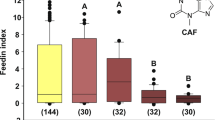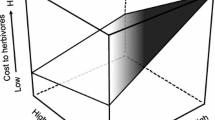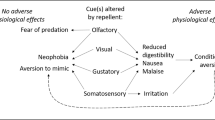Abstract
Many plant defensive chemicals are bitter to humans. Because of this taste characteristic, and because bitter compounds are often toxic, such substances, and the plants that contain them, are regarded as generally unpalatable to wildlife. These assumptions may be unwarranted. To test the hypothesis that herbivores are indifferent to ‘bitter’ tastants, we investigated the responsiveness of guinea pigs (Cavia porcellus) to denatonium benzoate, denatonium saccharide, limonene,l-phenylalanine, naringin, quebracho, quinine, Ro-Pel (a commercial animal repellent containing denatonium saccharide) and sucrose octaacetate. Only quinine and sucrose octaacetate slightly but significantly reduced feeding (P<0.05). Our findings are inconsistent with the notion that herbivores generally avoid what humans describe as bitter tastes.
Similar content being viewed by others
References
Beauchamp, G.K., andMason, J.R. 1991. Comparative hedonics of taste, pp. 159–184,in R.C. Bolles (ed.). The Hedonics of Taste. Lawrence Erlbaum Associates, Hillsdale, New Jersey.
Belitz, H.D., andWeizer, H. 1985. Bitter compounds: occurrences and structure-activity relationships.Food Rev. Int. 1:271–354.
Davis, S.F., Cunningham, L.A., Burke, T.J., Richard, M.M., Langley, W.M., andTheis, J. 1986. A preliminary analysis of the suppressive effects of denatonium saccharide.Bull. Psychon. Soc. 24:229–232.
Davis, S.F., Grover, C.A., Erickson, C.A., Miller, L.A., andBowman, J.A. 1987. Analyzing aversiveness of denatonium saccharide and quinine in rats.Percept. Mot. Skills. 64:1215–1222.
Freeland, W.J., andJanzen, D.J. 1974. Strategies in herbivory by mammals: The role of plant secondary compounds.Am. Nat. 108:269–289.
Garcia, J., andHankins, W.G. 1975. The evolution of bitter and the acquisition of toxiphobia, pp. 39–45,in D.A. Denton and J.P. Coughlin (eds.). Olfaction and Taste: Fifth International Symposium. Academic Press, New York.
Glendinning, J.I. 1992. Effectiveness of cardenolides as feeding deterrents toPeromyscus mice.J. Chem. Ecol. 18:1559–1575.
Glendinning, J.I., Brower, L.P., andMontgomery, C.A. 1990. Responses of three mouse species to deterrent chemicals in the monarch butterfly. I. Taste and toxicity tests using artificial diets laced with digitoxin or monocrotaline.Chemoecology. 1:114–123.
Jacobs, W.W. 1978. Taste responses in wild and domestic guinea-pigs.Physiol. Behav. 20:579–588.
Jacobs, W.W., andLabows, J.N. 1979. Conditioned aversion, bitter taste and the avoidance of natural toxicants in wild guinea pigs.Physiol. Behav. 22:173–178.
Jacobs, W.W., Beauchamp, G.K., andKare, M.R. 1978. Progress in animal flavor research, pp. 1–20,in R.W. Bullard (ed.). Flavor Chemistry of Animal Foods. American Chemical Society Symposium 67. American Chemical Society, Washington, D.C.
Langley, W.M., Theis, J., Davis, S.F., Richard, M.M., andGrover, C.M. 1987. Effects of denatonium saccharide on the drinking behavior of the grasshopper mouse (Onychomys leucogaster).Bull. Psychon. Soc. 25:17–19.
Lindroth, R.L. 1988. Adaptations of mammalian herbivores to plant chemical defenses, pp. 415–445,in K.C. Spencer (ed.). Chemical Mediation of Coevolution. Academic Press, San Diego.
Maga, J.A. 1990. Compound structure versus bitter taste, pp. 35–48,in R.L. Rouseff (ed.). Bitterness in Foods and Beverages. Elsevier, Amsterdam.
Mason, J.R., Reidinger, R.F., andStewart, C.N. 1985. Profiling, mimicking, and masking the flavor of a selected rodenticide.Physiol. Behav. 35:127–134.
Nolte, D.L., Mason, J.R., andClark, L. 1993. Avoidance of bird repellents by mice (Mus musculus).J. Chem. Ecol. 19:427–432.
Provenza, F.D., Burritt, E.A., Clausan, T.P., Bryant, J.P., Reichardt, P.B., andDistal, R.A. 1990. Conditioned flavor aversion: A mechanism for goats to avoid condensed tannins in blackbrush.Am. Nat. 136:811–828.
Provenza, F.D., Lynch, J.J., Burritt, E.A., andScott, C.B. 1993. How goats learn to distinguish between novel foods that differ in postingestive consequences.J. Chem. Ecol. Submitted.
Winer, B.G. 1971. Statistical Principles in Experimental Design. McGraw-Hill, New York, 907 pp.
Author information
Authors and Affiliations
Additional information
Post doctoral fellow at the Monell Chemical Senses Center at the time of the experiment.
Rights and permissions
About this article
Cite this article
Nolte, D.L., Russell Mason, J. & Lewis, S.L. Tolerance of bitter compounds by an herbivore,Cavia porcellus . J Chem Ecol 20, 303–308 (1994). https://doi.org/10.1007/BF02064438
Received:
Accepted:
Issue Date:
DOI: https://doi.org/10.1007/BF02064438




